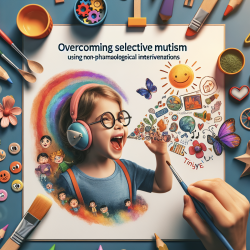Selective Mutism (SM) is a complex anxiety disorder that manifests in a child's inability to speak in specific social settings despite being able to speak comfortably in others. This condition can significantly impact a child's social, academic, and emotional development. Recent research titled "A systematic review and meta-analysis of nonpharmacological interventions for children and adolescents with selective mutism" offers valuable insights into effective interventions for this condition.
The study, conducted by Hipolito et al. (2023), systematically reviewed 25 studies on nonpharmacological interventions for children and adolescents with SM. The results highlight the importance of combined systems and behavioral approaches in improving speaking behaviors and reducing anxiety symptoms. Here’s how practitioners can leverage these findings to enhance their therapeutic practices.
Key Findings from the Research
- All studies reviewed reported an outcome measure for speaking behavior, and 18 used a measure of anxiety.
- Few studies reported measures of SM remission (6 studies), well-being (6 studies), academic impact (2 studies), or quality of life (1 study).
- Within-subject outcomes for nonpharmacological interventions showed variable improvements in speaking behaviors and anxiety reduction.
- Combined systems/behavioral approaches demonstrated significant and large effects on improved speaking behavior compared to waitlist controls (Hedges g = 1.06, p < .0001).
Implementing the Research Outcomes in Practice
Based on these findings, practitioners can adopt several strategies to improve their therapeutic outcomes for children with SM:
1. Emphasize Combined Systems and Behavioral Approaches
The research underscores the effectiveness of combined systems and behavioral interventions. These approaches involve integrating various therapeutic techniques, such as:
- Behavioral interventions (e.g., gradual exposure, reinforcement)
- Systems interventions (e.g., involving family, school, and other key stakeholders)
Practitioners should consider developing individualized treatment plans that incorporate these elements to address the multifaceted nature of SM.
2. Utilize Standardized Outcome Measures
One of the study's critical findings is the inconsistency in outcome measures across different studies. Practitioners should use standardized tools to measure:
- Speaking behavior
- Anxiety levels
- SM remission
- Well-being
- Academic impact
- Quality of life
Standardizing these measures will help in tracking progress more accurately and making data-driven decisions in treatment planning.
3. Foster Collaborative Efforts
Effective treatment of SM often requires collaboration among various stakeholders, including parents, teachers, and other professionals. Practitioners should:
- Engage parents in the therapeutic process
- Work closely with school personnel to create supportive environments
- Coordinate with other healthcare providers to ensure a holistic approach
Collaboration can enhance the consistency and effectiveness of interventions across different settings.
4. Continue Research and Professional Development
While the current research provides valuable insights, it also highlights the need for further systematic evaluations. Practitioners should stay updated with the latest research and consider contributing to the field by:
- Participating in clinical trials and studies
- Engaging in professional development opportunities
- Sharing successful intervention strategies with the broader community
Continued research and knowledge sharing will help refine and improve treatment approaches for SM.
Conclusion
Selective Mutism is a challenging condition, but recent research offers promising strategies for effective intervention. By adopting combined systems and behavioral approaches, utilizing standardized outcome measures, fostering collaborative efforts, and continuing research, practitioners can make significant strides in helping children with SM overcome their communication barriers.
To read the original research paper, please follow this link: A systematic review and meta-analysis of nonpharmacological interventions for children and adolescents with selective mutism.










